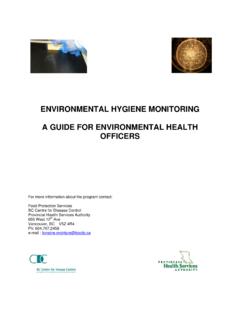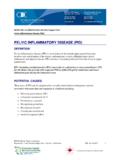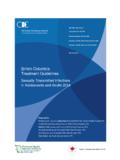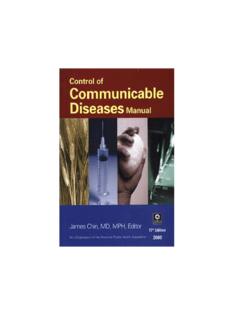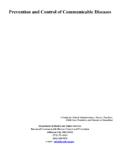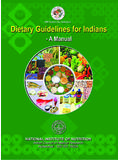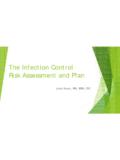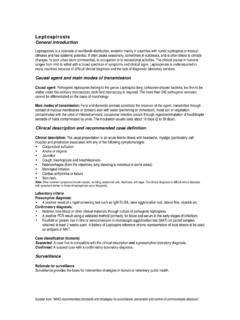Transcription of Communicable Disease Control Manual Chapter 2 ...
1 Immunization Programs & Vaccine Preventable Diseases Service 655 West 12th Avenue Vancouver, BC V5Z 4R4 Tel Fax Communicable Disease Control Manual Chapter 2: Immunization Part 1 - Immunization Schedules Table of Contents Vaccine Abbreviations and Vaccines ..2 1. Guidelines for Immunization Schedules ..3 Consideration of Immunization History .. 4 Considerations for Clients Initiating or Resuming Immunization at 7 Years of Age and Older .. 4 2. Routine Schedules ..5 Schedule A: Basic Immunization for Children Starting Series at 2 Months of Age .. 5 Schedule B: Children 1 to 6 Years of Age (Inclusive) When Starting or Resuming Immunization .. 6 Schedule C: Children and Adolescents 7 to 17 Years of Age (Inclusive) When Starting or Resuming Immunization .. 7 Schedule D: Adults Age 18 and Older When Starting or Resuming Immunization .. 9 Schedule E: Routine Immunizations for Adults Who Have Completed a Primary Series of Childhood Vaccines.
2 11 3. Minimum Intervals Between Vaccine Doses .. 12 Minimum Intervals Between Vaccine Doses Table .. 13 4. Timing and Spacing of Biological Products .. 15 Timing and Spacing of Inactivated Vaccines .. 15 Timing and Spacing of Live Attenuated Vaccines .. 15 Spacing of Vaccines and Antibody-Containing Products .. 16 Spacing of Vaccines and Blood Donation .. 17 Vaccination Following Vaccine Administration Errors .. 17 Vaccine or Antigen Given at Less than the Minimum Interval .. 17 Vaccine Given at Less than the Minimum Age .. 18 Live Vaccines Given Less than 4 Weeks Apart .. 18 Expired Vaccine .. 18 Tuberculin Testing .. 18 5. References .. 19 Communicable Disease Control Manual May 2017 Chapter 2: Immunization Part 1 - Immunization Schedules 1 Vaccine Abbreviations and Vaccines The table below provides a list of the abbreviations used in this section and the vaccines to which they refer. For information on specific vaccines and their use see Part 4 Biological Products.
3 Abbreviation Vaccine DTaP-HB-IPV-Hib Diphtheria and tetanus toxoids, acellular pertussis, hepatitis B, inactivated polio and Haemophilus influenzae type b vaccine DTaP-IPV-Hib Diphtheria and tetanus toxoids, acellular pertussis, inactivated polio and Haemophilus influenzae type b vaccine HA Hepatitis A vaccine HB Hepatitis B vaccine available on its own or in combination format as DTaP-HB-IPV-Hib as INFANRIX hexa Hib Haemophilus influenzae type b vaccine available on its own or in combination format as DTaP-HB-IPV-Hib or DTaP-IPV-Hib vaccines HPV9 Human papillomavirus vaccine (nonavalent, HPV types 6, 11, 16, 18, 31, 33, 45, 52, and 58) Flu Influenza vaccine IPV Inactivated polio vaccine available on its own or in combination format as DTaP-HB-IPV-Hib, DTaP-IPV-Hib, Td/IPV or Tdap-IPV vaccines Men-C-C Meningococcal serogroup C conjugate vaccine Men-C-ACYW-135 Meningococcal quadrivalent conjugate vaccines (serogroups A, C, Y, W-135) MMR Measles, mumps and rubella vaccine MMRV Measles, mumps, rubella and varicella vaccine PCV13 Pneumococcal conjugate vaccine, 13-valent vaccine PPV23 Pneumococcal polysaccharide vaccine, 23-valent Rota Rotavirus vaccine: monovalent (ROTARIX ) or pentavalent (RotaTeq ) Td Tetanus and diphtheria toxoids vaccine Tdap Tetanus and diphtheria toxoids and acellular pertussis vaccine Tdap-IPV Tetanus and diphtheria toxoids, acellular pertussis and inactivated polio vaccine Td/IPV Tetanus and diphtheria toxoids and inactivated polio vaccine Var Varicella vaccine Communicable Disease Control Manual April 2018 Chapter 2.
4 Immunization Part 1 - Immunization Schedules 2 for Immunization SchedulesOptimal response to a vaccine depends on many factors, including the nature of the vaccine and the age and immune status of the recipient. Adhere as closely as possible to recommended vaccine schedules. Recommendations for the age at which vaccines are administered are influenced by age-specific risks for Disease , age-specific risks for complications, ability of persons of a certain age to respond to the vaccine, and in infancy, potential interference with the immune response by passively transferred maternal antibody. Recommended ages and intervals between doses of vaccines and toxoids provide optimal protection or have the best evidence of efficacy. Recommended ages and intervals may differ from those contained in the product monographs and are based on research and expert opinion. For premature infants, chronological age based on actual birth date should be used as opposed to corrected age.
5 There is no minimum weight for commencing immunization. Use each client contact as an opportunity to review immunization status and administer all vaccines for which the client is eligible. Clients should also be informed of the availability of other vaccines that are recommended by the National Advisory Committee on Immunization but are not currently publicly funded. Determine vaccine eligibility by assessing the client s: Age Health status and underlying medical conditions Lifestyle or occupational risk factors Contact with individuals at risk of vaccine preventable Disease Local Disease general, individuals who missed being immunized on the routine schedule remain eligible for indicated vaccines and these should be offered at opportune encounters with an immunization service provider. In some instances, these vaccines will no longer be indicated beyond a certain age. In other instances, the individual remains eligible for the vaccine, however the recommended product may change depending on the individual s age.
6 See Part 4 Biological Products for vaccine eligibility and recommended product/schedule. The number of doses required to complete a series may be reduced for some vaccines as children age out of infancy or early childhood. When an individual presents, assess any previously received doses against the schedule for their current age and complete the series according to the schedule appropriate for their age. Interruption of a recommended series does not require starting the series over again, regardless of the interval elapsed (with the exception of oral typhoid vaccine). A longer than recommended interval between vaccine doses does not reduce final antibody concentrations, although protection might not be attained until the recommended number of doses has been administered. Communicable Disease Control Manual May 2017 Chapter 2: Immunization Part 1 - Immunization Schedules 3 By contrast, doses given at less than the minimum interval or minimum age may result in less than optimal antibody response and should generally not be counted as part of the series.
7 The full recommended vaccine dose volume should be administered. The recommended dosages of biological products are derived from clinical trials and post-marketing research. Administration of amounts smaller than those recommended and administration of divided doses such as half doses given over two visits is likely to result in inadequate protection. If a partial dose has been given it should be considered invalid and a full dose given subsequently. Exceeding the recommended dosage volume is not necessary to achieve protection and may result in an increase in adverse events, especially local reactions, due to excessive concentrations of antigens. Certain vaccines ( , Td) produce increased rates of local or systemic reactions in some recipients when administered too frequently. Such reactions may be the result of the formation of antigen-antibody complexes and are not allergic reactions. Consideration of Immunization History A verbal history of immunization is not considered proof of immunity.
8 When a client presents without written documentation of immunization, a thorough assessment of the reliability of the verbal immunization history as well as risk factors for vaccine preventable diseases should be undertaken. At minimum, a verbal history should include date (day/month/year) and sufficient information to identify the product administered ( , the generic name or product name). If the provider determines that the history is unreliable or the risk of Disease acquisition is assessed to be high, the client should be considered unimmunized and should be offered immunization according to the schedule for their current age. Written documentation may include that recorded in the Child Health Passport, on the CANI mmunize app, or other client-held records. A verbal history of a vaccine preventable Disease is generally not sufficient proof of immunity against that Disease but varies by Disease and by age. Considerations for Clients Initiating or Resuming Immunization at 7 Years of Age and Older When developing a schedule for an unimmunized or incompletely immunized client, it is important to consider several factors including age at presentation, health status, lifestyle or occupational risk factors, local epidemiology of vaccine preventable diseases, and for children, future opportunities to participate in school-based immunization programs (grades 6 and 9).
9 Since each situation is different, the client may be best served by developing a personalized schedule. The recommendations in subsections and (schedules C and D) will guide the development of the schedule for routine immunization of children, adolescents and adults, and should be used in combination with the relevant Biological Product pages (see Part 4 Biological Products and Minimum Intervals Between Vaccine Doses Table). For guidance in developing schedules for medically fragile clients and other special populations, see Part 2 Immunization of Special Populations. Communicable Disease Control Manual May 2017 Chapter 2: Immunization Part 1 - Immunization Schedules 4 Schedule A: Basic Immunization for Children Starting Series at 2 Months of Age The following recommendations will guide the development of the schedule for healthy children and adolescents, and should be used in combination with the relevant Biological Product pages (see Part 4 Biological Products).
10 Children with specific health conditions and/or risk factors should be immunized according to principles outlined in Part 2 Immunization of Special Populations. Age Vaccine 2 months DTaP-HB-IPV-Hib (or DTaP-IPV-Hib and HB) A PCV13 Men-C-C B Rota C 4 months DTaP-HB-IPV-Hib (or DTaP-IPV-Hib and HB) PCV13 D Rota C 6 months DTaP-HB-IPV-Hib (or DTaP-IPV-Hib and HB) Rota C HA (Aboriginal infants only) Flu E On or after 1st birthday MMR Var PCV13 Men-C-C 18 months DTaP-IPV-Hib HA (Aboriginal infants only) School Entry (4-6 years of age) Tdap-IPV MMRV F Grade 6 HPV9 (2 doses 6 months apart) Var (not required if 2 doses already received) Grade 9 Men-C-ACYW-135 Tdap G A The primary series of 3 doses of DTaP-containing vaccine should be completed with the same product. B For high risk infants, Men-C-ACYW-135 (Menveo ) should be given in place of Men-C-C and administered at 2, 4 and 12 months of age C Give 1st dose of rotavirus vaccine no later than 20 weeks less 1 day of age.



